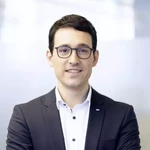
Within the framework of sustainability
Mar 23, 2023
In order to be able to launch sustainable financing instruments more quickly, the Dürr Group has laid down the basic principles for this in a framework. Christian Aue, Head of Treasury, and Hanjo Hermann, Head of Corporate Sustainability, answer the most important questions regarding the new → Sustainable Finance Framework.
Why has the Dürr Group adopted a framework for green financing?
Aue: We want to make the principles of our sustainable corporate financing transparent for the capital market. This includes, for example, the question of which sustainability goals we want to be measured against when we issue Schuldschein loans or bonds with a sustainability component.
Hermann: With the Sustainable Finance Framework, we are also driving forward the transformation within our own company. That’s because the principles set out in the framework enable us to use the money in areas in which we want to become more sustainable. Examples include measures to increase energy efficiency and the expansion of our self-generated electricity.
How can a Schuldschein loan be sustainable?
Aue: We conclude an additional agreement with the Schuldschein buyers: We link the interest on our financing to specific sustainability goals, such as the reduction of our CO2 emissions. If we achieve the goals, we will pay less interest. This is not only great for us and the environment. Our investors see that we are on the right track when it comes to sustainability — a key component of our → strategy — which, in turn, is positive for the Group. If we fail to meet our sustainability goals, we will have to pay more interest. Then the investors are compensated, so to speak, for the fact that we do not meet a target agreed with them.
The market for green investments has been growing significantly for years. Investors are increasingly looking for investment opportunities in sustainable business sectors.
Hanjo Hermann, Head of Corporate Sustainability
Why are green financing instruments so important for companies like the Dürr Group?
Hermann: The market for green investments has been growing significantly for years. Investors are increasingly looking for investment opportunities in sustainable business sectors. However, demand is rising not only from private and institutional investors, but also from commercial banks. These are attaching increasing importance to a credit portfolio with the lowest possible climate and environmental risks.
Aue: The fact that we are transparent about the sustainable projects in which our funds are invested meets with great approval from the capital market. We expect increased demand for future financing, which should have a positive impact on conditions.
Other companies have already adopted a sustainable finance framework. What is so special about the Dürr Group’s framework?
Hermann: We are one of the first companies to comply with the new rules of the EU Taxonomy Regulation, which has been in force since 2022. In simplified terms, it represents a Europe-wide classification system that specifies criteria for environmentally sustainable business activities, thus enabling external parties to see how sustainably a company is operating. The associated duty to report does mean considerably more effort. However, we see this as an opportunity because it allows us to show how much we have already initiated in the area of sustainability and what we are still planning to do.
72 points
were awarded to the Dürr Group in the EcoVadis sustainability rating, to which the company’s financing instruments with a total volume of
€1.4 billion
are linked. The better the rating, the lower the interest rates. The Dürr Group has achieved Gold status in the EcoVadis rating, placing it among the top 5% of all companies assessed.
Where do the proceeds from green financing go?
Aue: Our Sustainable Finance Framework stipulates that these proceeds may only be used for projects that comply with the Taxonomy Regulation. These may be photovoltaic systems on the roofs of our buildings, but also the development of sustainable products for our customers. Examples include machine technology for the construction of climate-friendly timber houses and coating systems for the production of batteries such as those required for e-cars. We will report annually on how we use the proceeds from green financing. This is also provided for by our new framework.
The Dürr Group intends to help customers reduce their carbon footprint with its products. How high is the demand for particularly sustainable solutions?
Hermann: For a long time, most customers focused on the short-term return on an investment. We have been noticing a shift in attitude for two years now, with more and more customers wanting to know how sustainable a technology is and how it performs over its entire life cycle in terms of CO2 emissions. This is particularly true for large automotive manufacturers, which now clearly demand sustainable action from their suppliers.
Thank you for the interview.
More information about our sustainable corporate financing:
- Our → Sustainable Finance Framework
- The Dürr Group as a pioneer in green financing: → Sustainable Finance at the Dürr Group
- Aligning financing and business activities to the principles of sustainability: → Board of Management interview
We want to make the principles of our sustainable corporate financing transparent for the capital market.
Christian Aue, Head of Treasury

Hanjo
Hermann
Senior Manager Corporate Sustainability
Dürr Aktiengesellschaft
Carl-Benz-Str. 34
74321 Bietigheim-Bissingen
Germany
Carl-Benz-Str. 34
74321 Bietigheim-Bissingen
Germany













